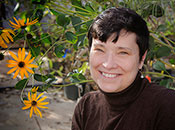
 |
John MulletProfessor Department of Biochemistry and Biophysics Sorghum – A Drought Tolerant Grain, Forage and High Biomass Crop Crops that are productive in water-limiting environments are of increasing importance due to the need to produce more food, feed and bioenergy for an expanding world population and because the world’s climate is becoming hotter and drier. Sorghum crops are grown in water-limited regions of agricultural production because this C4 grass expresses traits that contribute to water use efficiency, drought tolerance, and resilience to a wide range of adverse environmental conditions. Sorghum diverged from a common ancestor with rice ~60 MYA and subsequently developed C4 photosynthesis which aids adaptation to hot and dry environments. C4 photosynthesis and other adaptive traits aided the spread of sorghum throughout Africa, India and Australia. Sorghum was domesticated ~5-7,000 years ago with minimal impact on diversity and adaptation due to extensive outcrossing with wild sorghum. Sorghum germplasm used for breeding grain, forage and high biomass sorghum crops is therefore very diverse providing a source of alleles for numerous adaptive traits. Sorghum has a thick wax cuticle, leaves that osmotically adjust, roll, and become more vertical in response to water deficit. In the vegetative phase, sorghum plants can tolerate long periods (~6 weeks) without rainfall, progressing through stages of adaptation that include maintenance of root growth, reduction of transpiration, and eventual loss of canopy. Sorghum exhibits genotypic variation in vapor pressure deficit (VPD) induced stomatal closure, a trait that reduces water use at high VPD when transpiration efficiency is low. Modeling showed that deployment of this trait in high biomass sorghum with long growth duration would enhance biomass yield and delay onset of canopy loss that can occur under conditions of water limitation (Truong et al., 2017). High biomass sorghum also grows extensive and deep root systems that enable extraction of water and nutrient resources from the soil profile. Root growth and proliferation under conditions of water deficit, and QTL that modulate root angle, nodal root number, and tip proliferation have been identified. Grain sorghum is well known for drought tolerance traits such as stay-green that increase grain yield in water limiting conditions. Stay-green QTL have been identified, NILs developed, and the physiology associated with stay-green expression characterized (Borrell et al., 2016). Stay-green QTL (Stg1-4) shift water use from the vegetative to reproductive phase through reduction in tillering and leaf size. The drought tolerance and productivity of high biomass sorghum and grain crops will be discussed in the context of optimizing land use to maximize agricultural productivity. |
 |
Jeff HabbenSenior Research Manager Trait Discovery and Optimization Transgenic and CRISPR Cas enabled advanced breeding approaches to improving the grain yield of maize under drought stress conditions Lack of sufficient water is a major limiting factor to crop production, and the development of drought-tolerant germplasm is desired. We have used multiple approaches to show that modifying ethylene biosynthesis or signaling can enhance the drought tolerance of maize. Initially we demonstrated that reducing the expression of ACS6 (a gene that encodes an ethylene biosynthetic protein) can increase grain yield under field drought-stress conditions. Subsequently, we discovered a family of novel negative regulators of ethylene signal transduction in Arabidopsis and maize. These regulators are encoded by the ARGOS gene family, and in transgenic plants overexpression of ARGOS genes reduces ethylene sensitivity. Field testing showed that ARGOS8 maize transgenic events had a greater grain yield relative to controls under both drought-stress and well-watered conditions. We then used a CRISPR-Cas-enabled advanced breeding technology approach to generate novel variants of ARGOS8. The native maize GOS2 promoter, which confers a moderate level of constitutive expression, was inserted into the 5’-untranslated region of the native ARGOS8 gene, or was used to replace the native promoter of ARGOS8. A field study showed that relative to the comparator, the ARGOS8 variants increased grain yield by five bushels per acre under flowering-stress conditions and had no yield loss under well-watered conditions. We believe that continued advancement in our understanding of the key biological processes in maize will enable significant improvements in sustainable crop productivity. |
 |
Timothy CrewsDirector of Research, Lead Scientist Ecology Program Will drought tolerance improve if agriculture mimics natural systems? Dr. Crews' research focuses on achieving new levels of ecological intensification in perennial grain agriculture that go beyond what is possible in the the annual grain farming systems that feed us today. In the symposium on "Drought Tolerance in Agricultural and Natural Ecosystems,” Dr. Crews will discuss how the structure and function of native grasslands can provide useful models for improving--up to a point-- on the resilience of agriculture in the face of drought. |
 |
Troy OcheltreeAssistant Professor Department of Forestry and Rangeland Stewardship The fundamental role of hydraulic traits in understanding water-use strategies: Opportunities and limitations for applying research across agricultural and natural ecosystems. Research in my lab is focused on understanding the mechanisms underpinning different drought responses of plants. The water transport pathway through plants can fail as soil moisture becomes limited but the mechanisms of this process are still not fully understood. Some of the work in my lab is focused on identifying these mechanisms and evaluating how the resistance to hydraulic failure varies across a range of species by linking the mechanisms of hydraulic failure to different water-use strategies. Through the linkage of these processes we are working to better understand how drought tolerance and water-use strategies of plants have led to community structure, ecosystem function, and plant productivity. As temperatures warm and water availability to plants decreases, understanding these process is becoming increasing important to understand the ecological implications of drought in order to make the best management decisions for the future of our natural resources. |
 |
Lisa DonovanDepartment Head, Distinguished Research Professor Department of Plant Biology Drought resistance strategies: lessons learned so far from wild and cultivated sunflowers. My research focuses on understanding how plant ecophysiological traits relate to plant performance, particularly in response to abiotic stress. For the symposium, I will bring together results from drought studies in wild sunflowers (Helianthus anomalus, H. porteri) and cultivated sunflowers (H. annuus) to address lessons learned so far and promising areas for future research. |
 |
Dan ManterResearch Plant Physiologist Soil Management and Sugarbeet Research Harnessing the Soil Microbiome for Increased Drought Resistance. Dr. Manter is a Research Soil Scientist in the Soil Management and Sugar Beet Research Unit (SMSBRU) of the USDA-Agricultural Research Service in Fort Collins, Colorado. His research examines soil biology and plant-microbial interactions aimed at optimizing soil health. Research emphasis is on developing new management strategies that incorporate our understanding of how microbial processes contribute to both soil and plant function; particularly, under biotic and abiotic stress. At this symposium, Dr. Manter will discuss some of the ways that microbes contribute to drought tolerance from both a soil and plant-microbial interaction perspective. |


